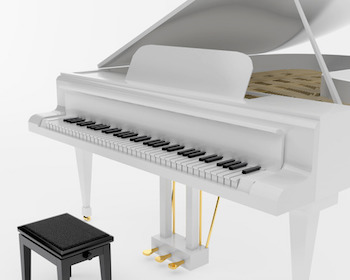When you look at a piano, you probably get caught up in the beauty of the instrument. The contrast between the black and white keys. The shine and splendor of the case. The richness of the sound.
Yet no matter where you put your focus on the instrument itself, beautiful, rich music would be nothing without the properties of the pedals. At first glance, they are simply levers located far enough away from all the other mechanisms, its easy to forget they are there. But using them effectively is an art form.
A professional piano player uses the pedals instinctively; they know how to use them to create the perfect sound. But this “pedal instinct” is one that is learned over many years of practice. What are they and how do you use them?
There are two standard pedals – the una corda and the sustain. The middle pedal is only standard on the American grand piano and is very rarely used.
The una corda is the pedal on the left, and is played with the left foot. It is also known as the soft pedal. The una corda pedal is used to enhance the differences between softly played notes, and is used to exaggerate a low volume. It should be used when playing notes softly to begin with; it will not enhance notes played with a loud voice.
The una corda works by shifting the strings slightly so that the hammers strike them in a softer manner, on a lesser used portion of the string. It allows the hammers to strike the string without full force, which also reduces the overall sound volume.
The sustain pedal is on the right and is played with the right foot. It is also called the damper pedal, the forte pedal, or the loud pedal. The sustain pedal allows the notes to resonate after the keys have been played, and will continue for as long as the pedal is depressed. It allows all of the notes to echo and overlap as the dampers are lifted off the strings, allowing them to vibrate until the pedal is released.
The middle pedal – the sostenuto pedal – is played with the right foot, yet is rarely used. The sostenuto pedal is called the tone sustaining pedal, and allows certain notes to be sustained while other notes are unaffected. It is used by hitting the desired notes, then depressing the pedal. The notes will be affected until the pedal is released. Because it is rarely used, it is not considered a standard addition to a piano, and is often only found on American grand pianos.
As your piano playing becomes more sophisticated and your music becomes richer and more vibrant, you will begin to see marks in the music for including the pedals. Like making music with the piano, the pedals also take time to learn, and will become better with practice.
Have additional questions? Give us a call. With over 50 years in the music business, we can answer any question you may have.

